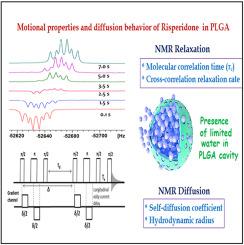NMR relaxation and diffusion studies to probe the motional dynamics of risperidone within PLGA microsphere
Abstract
The present study aims to investigate the motional dynamics of risperidone within polylactic co-glycolic acid (PLGA) microsphere by employing solution state 1H and 19F nuclear magnetic resonance (NMR) measurements. Risperidone, a second-generation fluorinated antipsychotic drug used for the treatment of schizophrenia is commercially marketed as PLGA microsphere formulation resulting in prolonged release of the drug in solution. Although the current trend in the pharmaceutical market is to develop drug formulation with long-acting release (LAR) products, complete physicochemical characterization of such formulations are scarce. Especially the effects of microsphere encapsulation on the motional properties and diffusion behavior of the drugs are not discussed adequately in any of the earlier reports. We therefore, have employed NMR relaxation and diffusion measurements to decipher the interaction of PLGA cavity water with risperidone. A detailed analysis of NMR relaxation rates confirmed the event of encapsulation and the presence of local motion in the non-fluorinated end of risperidone. Further, the relaxation data indicated a significant alteration in 19F chemical shift anisotropy (CSA) and CSA/dipole-dipole (DD) cross-correlated relaxation mechanism and decreased effect of solvent relaxation pointing out reduced water concentration within the microsphere cavity. 1H and 19F diffusion coefficients of risperidone led to the information about hydrodynamic radius of risperidone in free and encapsulated states. Measurement of hydrodynamic radius supported the presence of limited water in PLGA cavity allowing higher translational mobility of risperidone after the encapsulation.


 求助内容:
求助内容: 应助结果提醒方式:
应助结果提醒方式:


